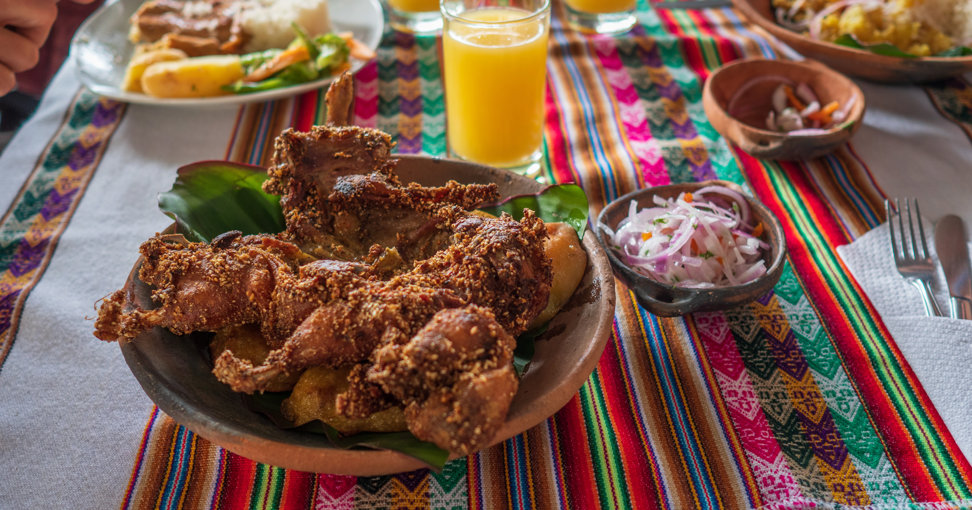Cuy chactado, an emblematic dish from the Peruvian highlands

History and origin
The gastronomy of the Peruvian highlands has gained recognition for its traditional dishes full of flavor and culture, with Cuy Chactado being one of the most emblematic. This dish has its roots in the ancient Inca civilization, where guinea pig (cuy) was considered a sacred food and a delicacy reserved for important ceremonies and religious celebrations. The Incas began breeding guinea pigs around 4000 B.C. and offered them to their gods as a sign of respect and gratitude.
Although some historians point out that the Spanish influenced the way cuy was prepared during colonization, the tradition and cultural importance of the dish remained intact among Andean communities. Cuy is not only a source of food but also a symbol of identity and cultural resistance.
Preparation and regional varieties
Cuy can be prepared in various ways depending on the region and local customs. However, Cuy Chactado is one of the most well-known preparations. The process begins by marinating the guinea pig in a mixture that typically includes crushed garlic, yellow chili pepper (ají amarillo), lemon juice, salt, and pepper. This marinade, which lasts at least an hour, allows the meat to absorb the characteristic regional flavors.
Next, the guinea pig is flattened and fried in plenty of oil until the skin becomes crispy and golden, giving it its characteristic flavor and texture. It is served whole, from head to paws, traditionally accompanied by native potatoes, white corn (mote), and spicy chili sauce, which further enhances its flavor.
In some areas, cuy is baked or grilled, while in others it is used in broths or stews, showcasing the versatility of this food in Andean cuisine.
Meaning of the name and tradition
The term chactado comes from Quechua and means “flattened” or “beaten.” It refers to the manual process of pressing the guinea pig with a special cooking stone, known as a jaca or jaka, to facilitate frying and ensure a perfectly crispy texture.
Beyond its culinary value, cuy holds deep symbolic meaning in Andean culture. It was an essential element in Inca religious ceremonies, especially during the Pachamama (Mother Earth) festival. Offering cuy to the earth was a way to ask for protection, fertility, and a good harvest.
Cultural and symbolic importance
Cuy has always been an essential source of protein for communities in the Peruvian highlands. During Inca times, local leaders (curacas) would request guinea pigs from matriarchs to nourish those in charge of important tasks. The preparation of cuy also followed specific rules and rituals, such as being cooked during the month of August for the agricultural festival Chacra Yapuy Quilla, dedicated to the renewal of land and crops.
During these festivities, the whole community would gather in the central square, where cuy was roasted with hot stones. It was believed that if the guinea pig had red eyes, it could not be eaten, as it signified that the participants had not yet finished asking forgiveness from Pachamama, reflecting the deep connection between food and spirituality.
Today, this tradition remains alive. Every second Friday of October, the Day of the Cuy is celebrated with food festivals and cultural events across various regions of Peru.
RECIPE
Ingredients:
- Cuy (guinea pig): The main ingredient and undeniable star of this dish. It is recommended to use a fresh, high-quality cuy for the best result.
- Ají amarillo (yellow chili pepper): This Peruvian chili adds a distinct flavor and color to Cuy Chactado.
- Garlic: Essential for seasoning the meat and adding its characteristic aroma.
- Lemon: Used for marinating the cuy and giving it a citrusy, refreshing touch.
- Corn flour: The key ingredient to achieve the crispy, golden crust that defines this dish.
- Salt and pepper to taste: For seasoning and enhancing the meat's flavor.
Preparation:
Making Cuy Chactado requires care and precision to achieve a delicious and crispy result. The following are the steps to prepare this traditional recipe:
Marinate: Wash and dry the cuy thoroughly. Marinate the meat with garlic, ají amarillo, lemon juice, salt, and pepper for at least one hour so it fully absorbs the flavors.
Coating: Coat the marinated cuy in corn flour, making sure it is completely covered to create a crispy layer when fried.
Frying: Deep-fry the coated cuy in hot oil until it is golden and crispy on the outside, while keeping the meat tender inside.
Serving: Serve Cuy Chactado with golden potatoes, criolla salad, and chili sauce to enhance its flavor and enjoy this delicious Andean dish.
Regional variations
Cuy Chactado is prepared differently depending on the region, giving the dish a unique culinary richness. Some regional variations include:
In Arequipa, it is typically served with rocoto relleno (stuffed spicy pepper) and chuño (freeze-dried potato).
In Cusco, it is prepared with a special seasoning made from aromatic herbs like huacatay.
SOURCES:
Perusabroso.net
Gusto y Sazon del Peru